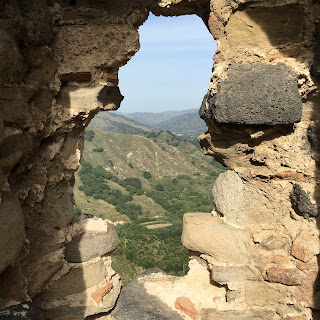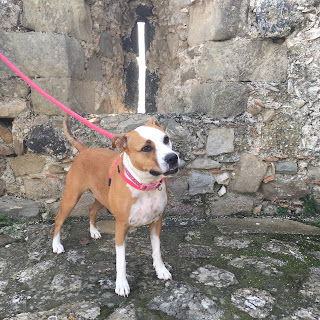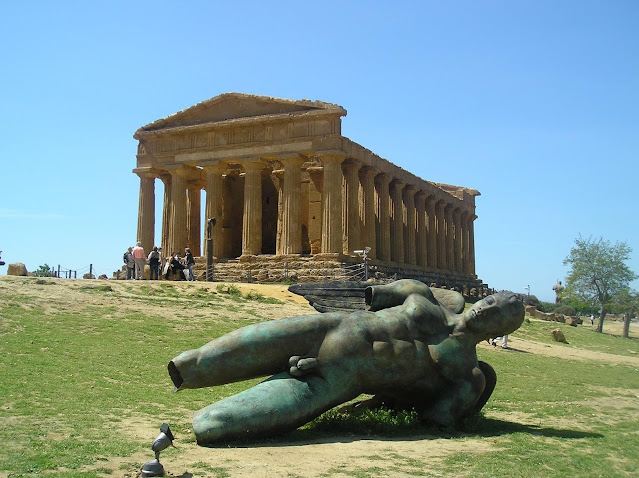The Arabic/Norman Castello Calatabiano
The autostrada from Catania to Taormina boasts fantastic
views, on your left you have Mount Etna and to your right the sparkling Ionian
Sea with towns dotted on both sides. Towards the end of your drive you will
spot Taormina in front of you giving the impression that the town tumbles down
towards the sea. Just before you turn off to exit the autostrada to your left
high above on a hill you will see a ruined Arabic Norman castle with a little
chapel.
30 meters below the castle you see the Holy Cross Church
inaugurated in 1484, the church was built in a late Gothic style with a
bell tower. The church houses the statue of San Filippo Siriaco who was
an early Christian confessor whose feast day is May 12th. He is
known as “Apostle of Sicilians” as he was the first Christian missionary to
visit the island and he is the protector of the town.
This is the Castello of Calatabiano.
The castle in its present form with its adjoining hillside
village was founded by the Arabs in 902AD when they came to the area to conquer
Taormina. The towns name is derived from Arabic Kalaat al Bian, (Kalaat meaning castle).
The castle stands on a hill 220 meters above sea level overlooking
Mount Etna, the Alcantara Valley, the bay of Giardini Naxos and Taormina. A
visit to the castle offers excitement and a landscape of unparalleled beauty from
the moment you get into the glass elevator which whisks you up the hill to the
castle.
The views from the castle are breath taking and you will be
able to take photos that are sure to create Insta-envy with your Instagram
followers.
The castle and its town below is situated in a strategic
location and many conflicts and sea battles happened nearby. In all likelihood given
the military importance of the site it is said that a fortress already existed
in the Greek era of Sicily. There is evidence from excavations that the castle
has been a stronghold by every invading occupier of the island.
 |
| Cable Car |
The town of Calatabiano was once situated around the top of
the hill with the castle but it moved downwards in the 17th century
when the village and castle were damaged and completely abandoned following the
devastating earthquake in 1693.
Under the Norman rule of King Roger II he elevated the town
to a feudal barony in 1135 and the town was cited in The Infamous Book of Roger which
was written in Arabic by the geographer Al-Idrisi in 1154.
Among the various Lords who succeeded over the centuries,
the most brilliant period in the history of Calatabiano came with the rule of
the Cruyllas Family of Catalan origin. The family obtained the barony in 1396
holding it for about a century, enlarging the castle and they also built the Church
of the Holy Cross located 30 meters below the castle. In the town of
Calatabiano you will see their coat of arms in various locations.
The castle can be reached by a winding path or by a cable
car which was built during the restoration of the castle. We visited on a very hot October morning with Daisy our dog and our lovely English friend Teresa who lives just down the road from us in Giardini Naxos.
Of the most interest is the entrance to the castle which consists
of a pointed arch of sandstone and lava stone from Mount Etna and also the 'Salon of Cruyllas' which
is divided by a lava stone arch which bears the insignia of the family and
boasts medieval charm.
Excavations carried out at the castle have revealed Greek
tiles, coins, jars and plates engraved with Greek letters all found under a layer
of Byzantine tiles. Round arches built with Roman bricks can be seen in the
mighty walls similar to that of other Roman structures in Taormina.
There is also a small concert hall where many musical
recitals are performed and the castle makes a perfect venue for a small romantic
wedding or special events. The restructuring also created a bar, restaurant and
conference room built within the castle in a modern style.
 |
| Holy Cross Church |
The traditional descent of San Filippo takes place on the Saturday
before the third Sunday of May and dates back to 1766. The fercolo with the statue
of the saint is carried from the Holy Cross Church in procession by devotees
around the town. The procession begins at 18:30 and the devotees run down the
bumpy path from the church, the fercolo with the statue weighs over a ton on
the shoulder and with the path full of pot holes accidents often occur. The festivities
in honour of the saint ends with the procession of the statues ascent back up
the mountain to the church. There is much celebration, food and fireworks in
the town of Calatabiano.
Outside the town there is a shrine dedicated to Our Lady of
the Empire which was built in 1092. It is dedicated to the Virgin Mary that 13
years before had witnessed the troops of King Roger in the victorious conquest
of the castle which was held at that time by the Arabs. Also worth a visit is
the Mother Church of Maria Santissima Annunziata located in the towns central
square Piazza Vittorio Emanuele III, it is a very beautiful church and inside
it preserves a precious wooden crucifix by Giovanni Salvo D’Antonio.
As you leave Calatabiano follow the signs for Castello San
Marco. Known as a castle it was actually a noble residence on the beach of San
Marco. It was on this beach that the dreaded pirate Dragut landed in 1544 who
stormed and looted the village of Calatabiano. Castello San Marco is now a
lovely romantic spa hotel and wedding venue with a lovely restaurant and private
beach.
 |
| Concert Hall |
Calatabiano is easily reached by car and is an approximate 20 minutes drive
from Taormina. I would recommend checking their website first before visiting for opening times due to concerts and special events. www.castellocalatabiano.it
Visit www.castellosanmarco.it for hotel bookings and reservations
Visit www.castellosanmarco.it for hotel bookings and reservations
The Eastern coastline of Sicily is stunning why not combine
a visit to the castle with a drive along the aptly named Rivieria dei Limone (Lemon Riviera) and experience the Coast of the
Cyclops and the beautiful historic town of Acireale.
If you enjoyed this Blog you might enjoy this posts from my
archive:
"a magical evening at Castello San Marco"
Thank you for following me at
White Almond Sicily Blogspot
White Almond Sicily Blogspot
For NEW Blog updates and all things Sicilian
Follow me at
Facebook www.facebook.com/whitealmondprivatesicily/
Instagram www.instagram.com/whitealmondsicily/
Twitter www.twitter.com/sicilyconcierge/
Follow me at
Facebook www.facebook.com/whitealmondprivatesicily/
Instagram www.instagram.com/whitealmondsicily/
Twitter www.twitter.com/sicilyconcierge/
Email me at WhiteAlmondSicily@Gmail.Com
for travel advice and recommendations
Love Sarah x



































